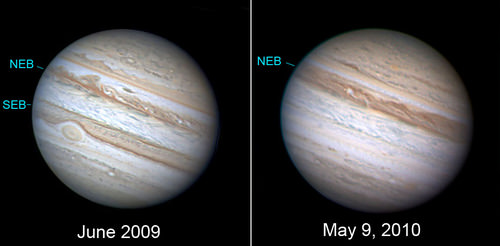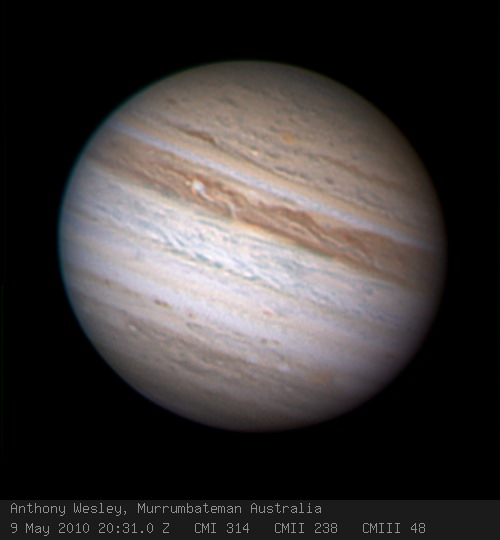[/caption]
Jupiter’s appearance has changed dramatically since the end of 2009, when it moved too close to the Sun from our vantage point on Earth to be observed. New looks at the planet after it emerged from the Sun’s glare reveals that one of the bands of clouds, the South Equatorial Belt, has gone missing. This image from amateur astronomer Anthony Wesley (the same astronomer who captured an impact spot on Jupiter last year) taken on May 9, 2010, shows a rather undressed Jupiter without its usually prominent southern band. See a comparison of earlier images below.

What caused the disappearance of the band? Astronomers aren’t sure, but this isn’t the first time this has happened. Back in 1973 when the Pioneer 10 spacecraft flew by and took the first close-up images of the planet, the southern band was missing, and it also disappeared in the early 1990s. Also, in 2007 cloud bands around its equator that had been light-colored for the past 15 years or so were noticeably darker.
Emily at the Planetary Society has written about this, and so has amateur astronomer Bob King, a.k.a “Astro Bob,” who explains:
“Every 3-15 years, the belt, which is normally dark reddish-brown in color and typically divided in two by the south equatorial belt zone, fades from view. After some weeks or months a brilliant white spot forms within that zone and begins spouting dark blobs of material which get stretched into filaments and ovals by Jupiter’s fierce winds into a new SEB. Within a few weeks (or longer) the belt is back and Jupiter presents its familiar dual “tire track” appearance through a telescope.”
Check out Anthony Wesley’s gallery of Jupiter images, and watch for new images over the next days and months to monitor the changes. Surely, Hubble and other observatories will be making new observations, as well.
Thanks to Anthony Wesley for sharing his images.


Does this phenomenon have any connection with the decametric emissions or Io sodium flux? What is the cause? The Northern hemisphere should be the mirror image of the southern , no ? Also does the northern band sink from view too or is it just a southern feature? how can this be?
Clearly global warming on Earth is to blame. If you selfish people didn’t drive SUV’s, this never would have happened?! What’s next, Saturn’s rings shoot off into space?! Al Gore, where are you?!
Theoretically, shouldn’t the Red Spot be effected also?
The differences shown in the above two photos is HUGE…….
It’s like Jupiter has its own El Nino / La Nina effects. Fluid dynamics are so hard to predict …
Is it my imagination or does Jupiter look naked in that picture? Naughty Jupiter!
By coincidence, a paper coauthored by Wesley was posted on arXiv.org today [see “The impact of a large object with Jupiter in July 2009” by Sanchez-Lavega et. al.: http://arxiv.org/abs/1005.2312 ] This paper contains Wesley’s original images as well as a comparison to the Shoemaker-Levy 9 impacts a decade before. Some truly inspiring work that started with an observation by an alert amateur astronomer.
It appears that the southern belt turns on and off. Here on Earth a northern atmspheric gyrus turned off this winter. This caused cold arctic air to pour over the northern hemisphere, causing the cold stormy winter this past year. This appears similar in a way, and such atmospheric streams or belts seem to be intermittent.
LC
Since Jupiter’s weather is mostly affected by it’s own internal energy (unlike Earth), it is likely some sort of internal process we can now attempt to explore, since there seems to be a pattern, not necessarily associated with the Sun.
LBC…
Where did you come up with “atmospheric gyrus”? You apparently don’t know much about climatology.
The cold weather in North America has been caused by the LaNina. Which is when sea surface temperature in the Tropical Pacific Ocean drops (sometimes as much as 7 degrees C.). This affects the normal track of the North American Jet Stream… in turn creating more circulation patterns in the atmospthere allowing cold air to move into North America.